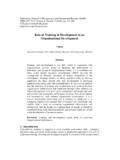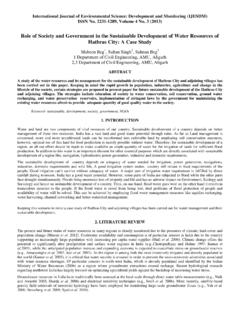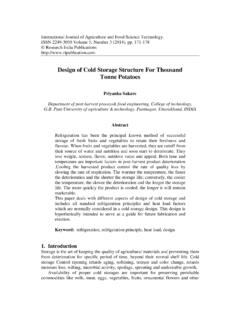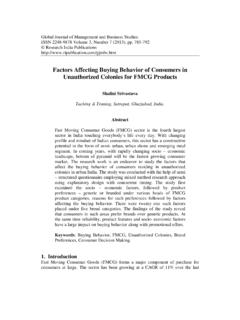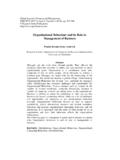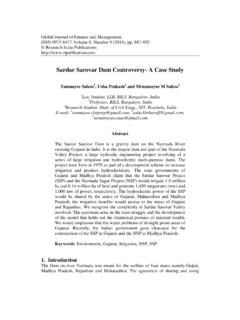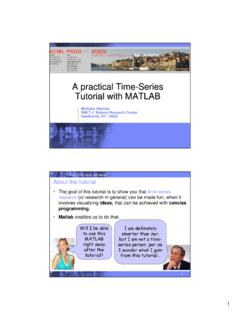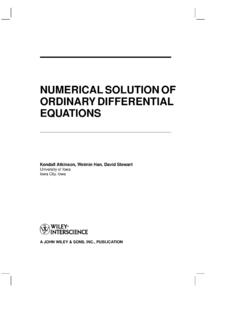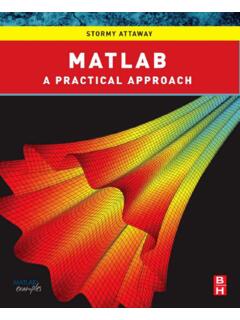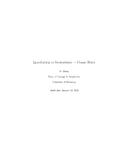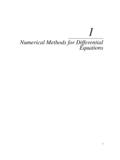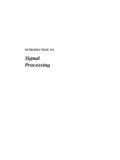Transcription of Illustration of Gauss Seidel Method Using Matlab
1 International Journal of Applied Engineering Research ISSN 0973-4562 Volume 14, Number 9 (2019) pp. 2234-2237 Research India Publications. 2234 Illustration of Gauss Seidel Method Using Matlab Riyasdeen S1, Abbas S2, Lenin T3 1 Assistant Professor, and Research Department of Mathematics, Marudupandiyar College, Pillayarpatti, Thanjavur, Tamilnadu, India. 2 Assistant Professor, and Research Department of Mathematics, Khadir Mohideen College, Adirampattinam, Thanjavur, Tamilnadu, India. 3 Associate Professor, and Research Department of Mathematics, Khadir Mohideen College, Adirampattinam, Thanjavur, Tamilnadu, India.
2 Abstract In numerical linear algebra, a solution to a linear system is an assignment of values to the variables such that all the equations in the systems are simultaneously satisfied. One of an iterative Method used to solve a linear system of equations is the Gauss Seidel Method which is also known as the Liebmann Method or the Method of successive displacement. It is named after the German mathematicians Carl Friedrich Gauss and Philipp Ludwig von Seidel , and is more or less similar to the Jacobi Method . Further this paper gives the Matlab code to solve the linear system of equations numerically Using Gauss Seidel Method .
3 Keywords: System of linear equations, Gauss - Seidel Method , Matlab solutions introduction Matlab Matlab is a very powerful software package that has many built-in tools for solving problems and for graphical illustrations (1). The name Matlab stands for MATrix LABoratory (2). The heart of Matlab is the Matlab language, a matrix-based language allowing the most natural expression of computational mathematics. The package Matlab provides an environment in which we can learn to programme and explore the structure of the numerical methods.
4 Gauss Seidel Method The Gauss - Seidel Method allows the user to control round-off error. Most of the elimination methods are liable to suffer from round-off error. This Method is modification of the Jacobi s iteration Method . It is defined on matrices with non-zero diagonals, but convergence is only guaranteed if the matrix is either diagonally dominant or symmetric positive definite (3). Also: If the physics of the problem are understood, a close initial guess can be made, decreasing the number of iterations needed. Basic Procedure: Algebraically solve each linear equation for the unknowns, say xi Assume an initial guess solution array for the given system of linear equations Solve for each unknowns xi and repeat the steps Use absolute relative approximate error after each iteration to check if error is within a pre-specified tolerance.
5 Algorithm: By this approach suppose we have an initial guess solution array, say (0)=( 1(0), 2(0),.., (0)), for the solution array of the given system of linear equation = , =1= , for =1,.., and we generate an improved solution estimate ( +1), from the previous solution estimate ( ). To generate an improved solution estimate ( +1), the Gauss - Seidel Method differs from the Jacobi Method in the fact that at the ( +1)-th step the available values of ( +1) are being used to update the solution, ( +1)= 1 [ ( ) =0 ], for =1.
6 , (4) Equation 1. Iteration formula of Gauss Seidel Method At the end of each iteration, one calculates the absolute relative approximate error for each xi as | | =| new old new| 100 (5) Equation 2. Error for Gauss - Seidel Method International Journal of Applied Engineering Research ISSN 0973-4562 Volume 14, Number 9 (2019) pp. 2234-2237 Research India Publications. 2235 Matlab Algorithm Go to file new M-file. Input the coefficient matrices and . Input the initial guess estimate for the solution of the given system of linear equations and the number of iterations to be performed.
7 If diagonal elements of the matrix are zero display the output enter the valid matrix to perform Gauss Seidel Method . Check the matrix for whether the matrix is diagonally dominant and positive definite or not, since the Gauss Seidel iteration Method assures that the numerical solution for the linear system converges to the original solution for any initial starting vector if the matrix is strictly diagonally dominant and positive definite. Then perform Equation 1. Iteration formula of Gauss Seidel Method to get the improved solution estimate.
8 Then perform Equation 2. Error for Gauss - Seidel Method to get the absolute relative approximate error at the given iteration. Save and run the file. Matlab program code % Gauss Seidal clc format compact A=input('Enter the Coeficient Matrix A: '); B=input('Enter the solution Matrix b (column matrix): '); C=[A B]; n=input('Enter the number of iteration: '); X=input('Enter the initial guess (Column matrix): '); x(1)=X(1,1); y(1)=X(2,1); z(1)=X(3,1); for j=1:3 %checking for zero in diagonal entries diag=0; if A(j,j)==0 diag=1; end end if diag==1 disp('Error!)
9 Please check the input, diagonal elements of the matrix cannot be zero') else eig_A = eig(A); %Checking for positive definite positive = 0; for i = 1:rank(A) if eig_A(i) <= 0 positive = 1; end end diagdom=0; %Checking for diagonally dominant for j=1:length(B) if abs(A(j,j))>= sum(abs(A(j,:)))-abs(A(j,j)) diagdom=1; end end for i=1:n %Iterative step x(i+1)=(1/C(1,1))*(C(1,4)-C(1,2)*y(i)-C( 1,3)*z(i)); y(i+1)=(1/C(2,2))*(C(2,4)-C(2,1)*x(i+1)- C(2,3)*z(i)); z(i+1)=(1/C(3,3))*(C(3,4)-C(3,1)*x(i+1)- C(3,2)*y(i+1)); error1=abs((x(i)-x(i+1))/x(i+1))*100; error2=abs((y(i)-y(i+1))/y(i+1))*100; error3=abs((z(i)-z(i+1))/z(i+1))*100; end end if positive == 1 disp('the matrix is not positive definite hence we can not expect convergence.
10 ') else if diagdom==1 disp('the matrix is positive definite and diagonally dominant hence, we can expect convergence.') else disp('the matrix is positive definite but not diagonally dominant hence we can not expect convergence. ') end end International Journal of Applied Engineering Research ISSN 0973-4562 Volume 14, Number 9 (2019) pp. 2234-2237 Research India Publications. 2236 error=[error1; error2; error3]; disp('a1= ') disp(x(i+1)) disp('a2= ') disp(y(i+1)) disp('a3= ') disp(z(i+1)) disp('Absolute relative approximate error for each a in %') disp(error) Problem The upward velocity of a rocket is given at three different times in the following table Time, ( ) Velocity ( / ) 5 8 12 Table 1.
